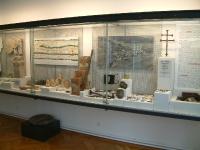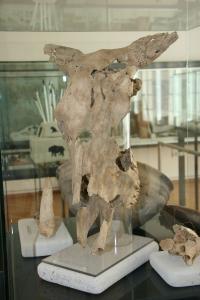Due to original fragments, a reconstruction of reliquary in which the bones of the saint were originally preserved could be carried out. The shrine and the bones originate from eastern Mediterranean area.
The chancel in the early Christian church was divided by a marble cabinet and pillars, and could be closed by curtains. Windows in the church were made of panes of glass.
The bones found include those of pig, sheep and goat as well as italic and Alpine cattle breeds. In 506, the Ostrogothic king Theoderich issued an order according to which the Noriker should replace their small Alpine cattle for bigger cattle deriving from fleeing Alemanni.
Hunting was irrelevant for the meat consumption of the people. Only 2.6 per cent of meat came from wild animals. Rats were eaten, too. For hunting, different arrowheads were used according to the species of animal. Besides, animal bones served as a raw material.
On the Mt. Hemmaberg, the casting of garment casts took place, which can be evident from a cocks brooch and an accompanying clay casting form. A gilded Alemannic bow brooch from the period round 490 and 520 AD was found in the accumulation of soil under the church floor.
Next to the entryway (today’s parking space), the archaeologists excavated more than 120 graves from the period between 400 and 600 AD. Approximately half of women and girls graves contained their personal jewellery.
Native clay vessels from the 6th century AD and charred millet were also excavated. Panicle millets were mostly found near fireplaces in the kitchen of the pilgrim houses.
A noble red shining tableware (Terra Sigillata) was imported from North Africa in the 5th century. Amphora and clay lamps, copied also in Upper Italy, derived from this area.
Native clay vessels from the 6th century AD and charred millet were excavated. Panicle millets were often found as grain near fireplaces in the kitchen of the pilgrim houses.
With the help of finds from all epochs, a big glass cabinet gives an overview of a rich history: Bronze Age, Celts, the Romans, Goths, Carinthians, Middle Ages and modern times.




